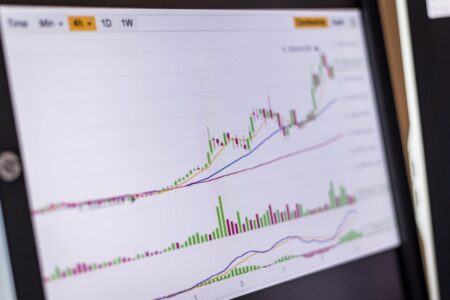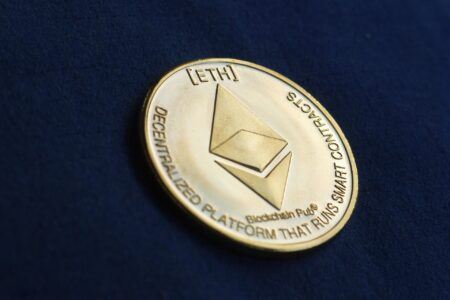According to CryptoCompare research, a huge premium on Bitcoin and high-cap altcoins has established itself on those cryptoasset exchanges using Tether (USDT) as a trading pair. This is especially true on the Bitfinex exchange, following the recent news that the New York Attorney General has accused Bitfinex of having an $850 million hole in their finances.
Bitfinex and Tether (the company) have for some time shared both banking relations and management, and their fates have historically been closely aligned.
This news resulted in a renewed spike of the notorious “Tether Premium,” whereby cryptos trading against Tether rise in price versus the same cryptos trading against real USD. These price rises are in some sense artificial, reflecting not an increased market value of the cryptoasset, but rather a decreased market value of the Tether stablecoin.
 (source: TradingView.com)
(source: TradingView.com)
Bad News
Before word got around of the New York Attorney General’s public affirmation of their allegations, Bitfinex’s Bitcoin premium was decidedly modest – with only about $50 difference versus real cash exchanges.
The news brought a considerable and abrupt fall in Bitcoin price, but only on Bitfinex and other Tethered exchanges was there a huge – and artificial – rebound of prices as sellers rushed to get rid of their USDT.
In something like the crypto equivalent of a bank run, the extreme eagerness to sell Tether surrounding concerns of its solvency caused its market price to drop. Thus, the Bitcoin trading against that falling asset has become relatively more valuable.
As mentioned above, one of the notable effects on the markets in the past few days has been the very artificial price recovery of Bitcoin and other cryptos that trade against Tether.
 (source: TradingView.com)
(source: TradingView.com)
As we can see, the dip was completely rebought on those exchanges, especially Bitfinex. We can see instead that exchanges supporting trading in real fiat USD, like Coinbase and Bitstamp, organically absorbed the price hit, and price recovery behaved completely differently on these platforms.
At time of writing, Bitcoin trading on Bitfinex is priced at a more than $300 premium – about 5% – versus real dollar-valued Bitcoin.
 (source: TradingView.com)
(source: TradingView.com)
Another item noted by CryptoCompare is that other Tether-using exchanges like Binance and Huobi are seeing vastly smaller premia than Bitfinex. At time of writing, both Binance and Huobi exchanges have less than $100 premia over real dollar Bitcoin. This means that Bitfinex has a “premium on the premium.”
An Abusive Relationship
As noted in the post, this is not the first time that Bitfinex and Tether have shaken the cryptoasset market. Indeed, it has become almost routine.
Finally, and this is the icing on the cake: reason Bitfinex is missing $850M is they placed over one billion dollars of commingled customer and corporate funds with a Panamanian payment processor … *without a contract*. And this Panamanian company is not returning the funds. pic.twitter.com/A6ya5bDnmH
— Alex Krüger (@krugermacro) April 30, 2019
CryptoGlobe reported late last year on $100 premia for Bitcoin exchanges trading against Tether, a sum that now seems modest compared to today’s disparities. Those premia were caused by fresh concerns regarding Bitfinex and Tether’s banking relationships – concerns which probably caused a significant hit to the entire crypto market at the time.
Yet despite these historical examples of Tether’s volatility, CryptoCompare’s March Exchange Review found that USDT still accounted for over 98% of stablecoin usage in the markets.
A Silver Lining?
It is hard to deny the huge role Tether has played during the last few years in supporting the cryptoasset markets, having been referred to in the past as Bitcoin and crypto’s “central bank.” Whether or not Tether itself is a healthy entity or safe to use, the utility of stablecoins in general in the crypto markets is undeniably huge – and Tether’s first mover advantage here has placed it as a central pillar of the industry.
This outsized role has long been a major concern for the industry, bearing in mind the almost constant speculation over past years that the duo are not fully solvent. Some of these speculations now seem at least partially confirmed, as Tether’s lawyers have yesterday admitted that their digital asset is not 100% backed.
And yet, as bad news continues to hit Tether, the damage to the crypto markets seems muted on the whole: Bitcoin has not even retested the critical $5,000 support zone after the initial dump, but rather has doggedly maintained support in the same general trading zone from all of April.
It’s been the crypto market’s worst fear […] now that it’s […] out of the way and out in the open, it’s actually better for the market because we don’t have it hanging over our heads anymore.
eToro financial and crypto market analyst Mati Greenspan shed some light on why this may be, during an April 29 interview, commenting that: “Even if Tether goes completely bust, that has no reflection on Bitcoin.” He highlighted the price dynamic between Tether and Bitcoin, namely that value flowing out of USDT will be “more likely” to flow into Bitcoin and other cryptos, and cause upward pressure on prices.
yeah people are bored of Tether but this is still a good prediction of what will happen if Tether shit hits the fan.https://t.co/wPnSWFYPSX pic.twitter.com/muoYllRsRR
— BambouClub (@BambouClub) April 27, 2019
In the wake of this definitive-seeming news regarding Tether, the stablecoin spotlight may finally begin to drift to competing assets. We can see, below, that the market capitalizations of many stablecoins – excluding Tether – saw a sharp spike when the news dropped last week.
 (source: StablecoinIndex.com)
(source: StablecoinIndex.com)
This can only be a good thing, as this central point of risk within the industry is distributed around to many assets instead of just one.











